
Australian Journal of Chemistry
Volume 72 Number 10 2019
Dedication to Professor Richard Robson
CHv72n10_FOProfessor Richard Robson FAA
The foreword to this special issue of the Journal dedicated to Professor Richard Robson provides an account of his distinguished career and his pioneering work in the field of coordination polymers and metal–organic frameworks.
CH19279Metalloligand Strategies for Assembling Heteronuclear Nanocages – Recent Developments
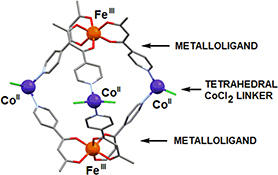
Strategies involving the use of metalloligands have increasingly been applied to the synthesis of a variety of metallosupramolecular cage assemblies. The popularity of this approach reflects its stepwise nature that lends itself to the predesigned construction of metallocages and especially heteronuclear metallocages. Recent representative developments for the construction of discrete polyhedral metallocages are presented.
CH19062Cocrystals and Salts of 3,5-Bis(pyridinylmethylene)piperidin-4-one with Aromatic Poly-Carboxylates and Resorcinols: Influence of Stacking Interactions on Solid-State Luminescence Properties
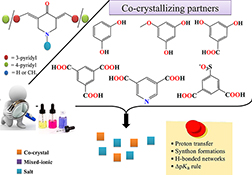
The reactions of bispyridyl ketones with resorcinol derivatives resulted in co-crystals containing predicted assemblies, whereas those with poly carboxylic acids resulted in salts with versatile assemblies.
CH19178Assembly, Structure, and Properties of Six Coordination Polymers Based on 1,3,5-Tri-4-pyridyl-1,2-ethenylbenzene
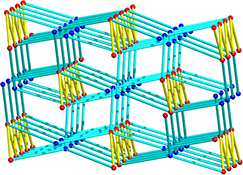
Six coordination polymers based on 1,3,5-tri-4-pyridyl-1,2-ethenylbenzene have been solvothermally prepared. They possess 1D chain structures (1–3), 2D layer network (4), and 3D (3,5)-connected nets (5 and 6). Complex 2 displays efficient photodegradation of rhodamine B in water while 5 presents highly selective probing of p-nitrophenol through fluorescence quenching.
CH19220Synthesis and Characterisation of Helicate and Mesocate Forms of a Double-Stranded Diruthenium(II) Complex of a Di(terpyridine) Ligand
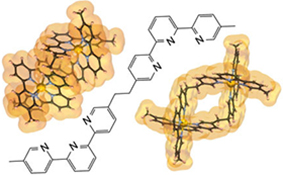
The diruthenium(ii) complex involving a di(terpyridine) ligand exists in double-stranded helicate and mesocate forms. Structural and NMR studies reveal significant differences between the two structures in cavity sizes, crystal packing, and rigidity. Both species emit at ~610 nm at 77 K, but emission lifetimes differ by three orders of magnitude.
CH19175[FeII(L•)2][TCNQF4•−]2: A Redox-Active Double Radical Salt
 , Jinzhen Lu, Ruchika Ojha, Mousa Asadi, David W. Lupton
, Jinzhen Lu, Ruchika Ojha, Mousa Asadi, David W. Lupton  , Blaise L. Geoghegan, Boujemaa Moubaraki, Lisandra L. Martin
, Blaise L. Geoghegan, Boujemaa Moubaraki, Lisandra L. Martin  , Alan M. Bond
, Alan M. Bond  and Keith S. Murray
and Keith S. Murray
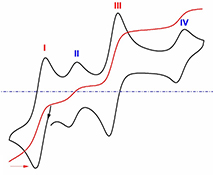
[FeII(L•)2][TCNQF4•−]2·2CH3CN (1) shows multiple well-resolved, diffusion-controlled, reversible one-electron processes.
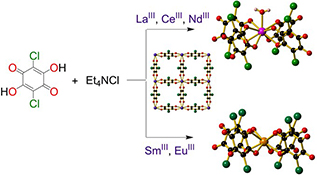
Six new lanthanide chloranilate framework materials featuring a square grid topology are reported. Two different coordination environments around the lanthanide ion were found, being dependent on the ion size. The larger lanthanide ions (La, Ce, Nd) were nine-coordinate with a coordinated aqua ligand whereas the smaller lanthanide ions (Sm, Eu) were eight-coordinate.
CH19213Synthesis and Characterization of Zn-Carboxylate Metal–Organic Frameworks Containing Triazatruxene Ligands
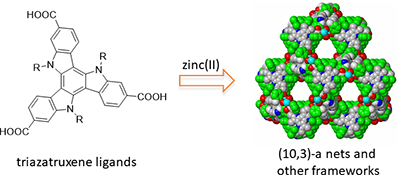
Trigonal triazatruxene-based tricarboxylate ligands with various substituents give rise to a series of interesting frameworks in association with zinc(ii).
CH19215Tuning Packing, Structural Flexibility, and Porosity in 2D Metal–Organic Frameworks by Metal Node Choice
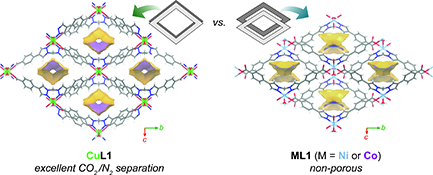
Subtle changes in the coordination sphere of the metal node induce changes in structure that transform a material with excellent CO2/N2 separation performance to one that is essentially non-porous.
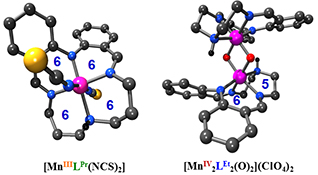
Monomeric and oxo-bridged dimeric manganese complexes of two flexible, anionic, [1 + 1] macrocycles, derived from diphenylamine-2,2′-dicarboxaldehyde and either diethyl- or dipropylenetriamine, are reported: both facial and meridional binding modes are observed.
CH19194The Elusive Nitro-Functionalised Member of the IRMOF-9 Family

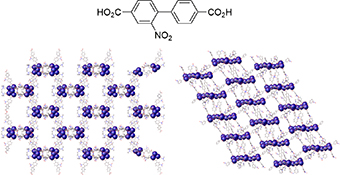
Solvothermal reaction of pure 2-nitro-[1,1′‐biphenyl]‐4,4′‐dicarboxylic acid (H2bpdcNO2) with Zn(NO3)2·6H2O in DMF solvent gives two highly open MOFs with pentazinc and dodecazinc secondary building units. Spiking H2bpdcNO2 with H2bpdc directs phase selection to the IRMOF-9-type framework. The gas adsorption properties of the latter framework are discussed.
CH19264Reversible and Vapochromic Chemisorption of Ammonia by a Copper(II) Coordination Polymer
 , David Nielsen
, David Nielsen  , Susanne Mossin
, Susanne Mossin  , Brendan F. Abrahams
, Brendan F. Abrahams  , Vickie McKee
, Vickie McKee  and Christine J. McKenzie
and Christine J. McKenzie 
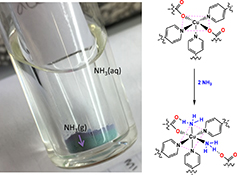
A turquoise crystalline CuII coordination polymer has a topology related to that of a 12,3 net. Removal of guest solvent produces a crystalline phase which chemisorbs, stepwise, two equivalents of ammonia per Cu site to produce a mauve adduct which is stable up to ~150°C before the reversible desorption of the chemisorbed NH3 (10 cycles).
CH19311A Copper Complex of a Thiosemicarbazone-Pyridylhydrazone Ligand Containing a Vinylpyridine Functional Group as a Potential Imaging Agent for Amyloid-β Plaques
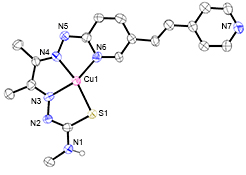
A new thiosemicarbazone-pyridylhydrazone tetradentate ligand featuring a pyridyl-4-vinylpyridine functional group that forms a stable complex with copper(ii) was prepared. The ligand could be radiolabelled with positron-emitting copper-64. The interaction of the copper(ii) complex with amyloid-β fibrils and plaques are described.
CH19221Halogen Functionalization of Aluminium Fumarate Metal–Organic Framework via In Situ Hydrochlorination of Acetylenedicarboxylic Acid
 and Christoph Janiak
and Christoph Janiak 
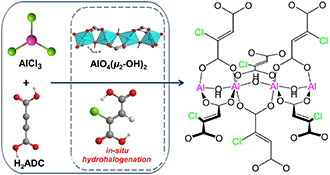
Chloro-functionalization of aluminium fumarate (MIL-53-Fum) enhances gas (CO2, CH4, and H2) sorption capacities and affinity compared with the non-functionalized MIL-53-Fum MOF
CH19255H2-Generation from Alcohols by the MOF-Based Noble Metal-Free Photocatalyst Ni/CdS/TiO2@MIL-101

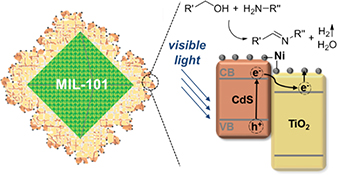
C–N bond formation reactions are generally central to catalytic organic synthesis. The recently reported Ni/CdS/TiO2@MIL-101 photocatalyst dehydrogenates alcohols under visible light illumination via liberation of H2. This additive and noble metal free approach allows for photocatalytic C–N multiple bond formation by dehydrogenative coupling/condensation reactions employing alcohols and amines.
CH19271Polyacids as Modulators for the Synthesis of UiO-66
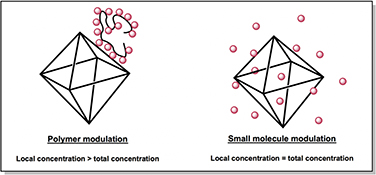
Polymer acids were used to control the growth the zirconium-based metal–organic framework UiO-66. In contrast to UiO-66 modulated by small molecules, structurally analogous polymer acids provide small particle sizes and narrow size distributions over a wide concentration range, including highly sub-stoichiometric.



